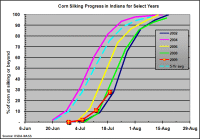Published 21 July 2009
URL: http://www.kingcorn.org/news/articles.09/GoodNewsBadNews-0721.html
Cool Temperatures: Good News or Bad News for Corn?
R.L. (Bob) Nielsen
Agronomy Dept., Purdue Univ.
West Lafayette, IN 47907-2054
Email address: rnielsen
at purdue.edu
The recent spate of unusually cool temperatures has been welcomed by county fairgoers, but some of the guys sitting around the back table at the Chat 'n Chew Cafe are wondering whether it is good news or bad news for a corn crop that has already experienced its fair share of stress this year. In all honesty, we can only speculate on the answer because it is so unusual for such temperatures to occur in mid-July that there is very little precedence to go by.
Potentially Good News
- Considering that the much of state's late-planted corn crop is just now moving into the critical pollination stage, cooler temperatures are preferable to stressfully hot temperatures.
- Ditto for earlier-planted corn that is now in the early stages of grain fill.
- The rate of development of certain leaf diseases, like gray leaf spot, may slow down.

Silking progress as of 7/19/09. Click
image to view larger version.
Potentially Bad News
- Cool temperatures equal fewer heat units (GDD) per day. That translates into slower corn development and will further delay the progress of much of the state's crop that was planted weeks later than normal to begin with and whose silking progress statewide was already 2 weeks behind the 5-year average.
- Unusually cool temperatures prior to silk emergence may result in the occurrence of the "silk balling" phenomenon, whereby silk elongation is interrupted or altered, resulting in a mass of scrambled silks near the tip of the cob that never fully emerge from the husk. The consequence of such scrambled silks is poor kernel set.
Related References
Nielsen, RL (Bob). 2000. Scrambled Silks, Anyone? Corny News Network, Purdue Univ. Online at http://www.kingcorn.org/news/articles.00/SilkBalling-0718.html [URL accessed 7/21/09].

